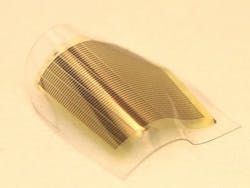Transistors with 'wavy' design to benefit flexible ultrahigh resolution displays (see video)
Flexible ultrahigh-resolution displays will greatly enhance next-generation mobile electronics, such as point-of-care medical diagnostic devices. Researchers at King Abdullah University of Science and Technology (KAUST; Thuwal, Saudi Arabia) have developed a transistor architecture that boosts the performance of the display circuitry.
Flat-panel displays used in smartwatches, mobile devices, and TVs rely on planar transistor circuits to achieve high-resolution and fast imaging. In these circuits, thin-film transistors, acting as switches, control the electric current that activates individual pixels, consisting either of light-emitting diodes (LEDs) or liquid crystal.
Future displays are expected to offer an even better visual experience through increases in resolution and frame rate. While transistor miniaturization can augment resolution, a higher field-effect mobility of the channel material can fulfill both these needs. It does this through its ability to facilitate electron and hole flows between contacts under applied voltage, which then allows transistors to switch faster and occupy a smaller pixel area.
To date, amorphous-oxide semiconductors, such as zinc oxide and indium-gallium zinc oxide, have provided transistor channels with modest mobility. Scaling down these transistors is expensive and introduces flaws known as short-channel effects that increase their power consumption and degrade their performance, explains Muhammad Hussain, who led the research team.
Finlike structures
As an alternative, Hussain's team has designed nonplanar vertical semiconductor finlike structures that are laterally interconnected to form wavy transistor arrays. The researchers opted for zinc oxide as the active channel material and generated the wavy architecture on a silicon substrate before transferring it onto a flexible soft polymer support using a low-temperature process.
(Video © 2017 Muhammad M. Hussain)
Thanks to the vertical orientation, the researchers widened the transistors by 70% without expanding their occupied pixel area, doubling the transistor performance. The wavy arrays exhibited reduced short-channel effects and higher turn-on voltage stability compared to their planar equivalents. Moreover, in a proof-of-concept experiment, they could drive flexible LEDs at twice the output power as their conventional counterparts. "The LEDs were brighter without increasing power consumption," says Hussain.
Source: https://discovery.kaust.edu.sa/en/article/459/making%250awaves-for-ultrahigh-definition-displays
About the Author
John Wallace
Senior Technical Editor (1998-2022)
John Wallace was with Laser Focus World for nearly 25 years, retiring in late June 2022. He obtained a bachelor's degree in mechanical engineering and physics at Rutgers University and a master's in optical engineering at the University of Rochester. Before becoming an editor, John worked as an engineer at RCA, Exxon, Eastman Kodak, and GCA Corporation.

